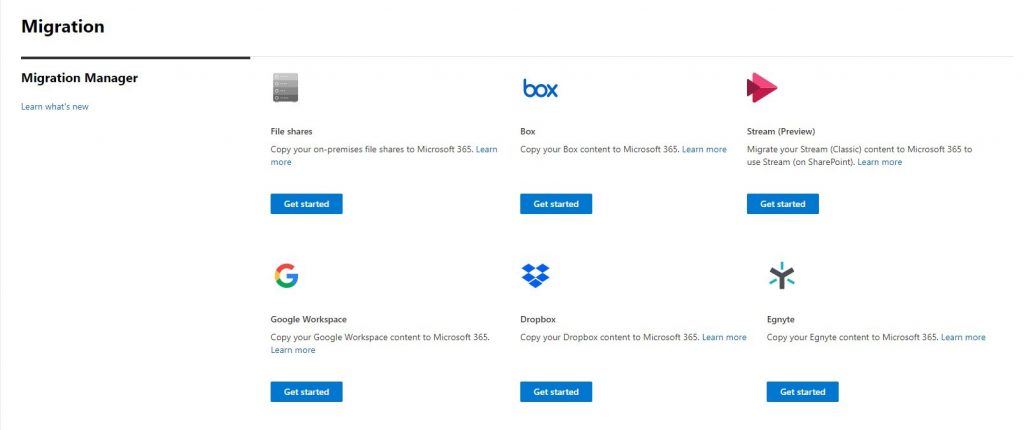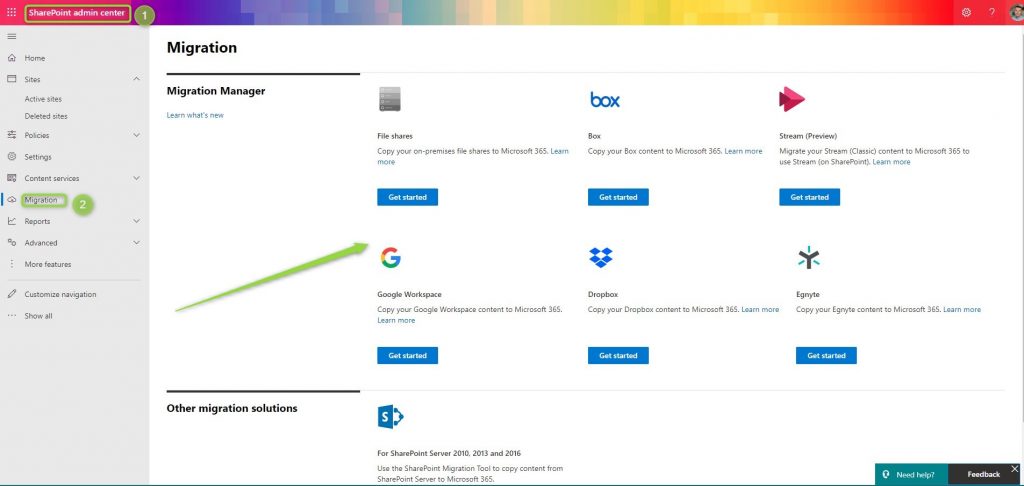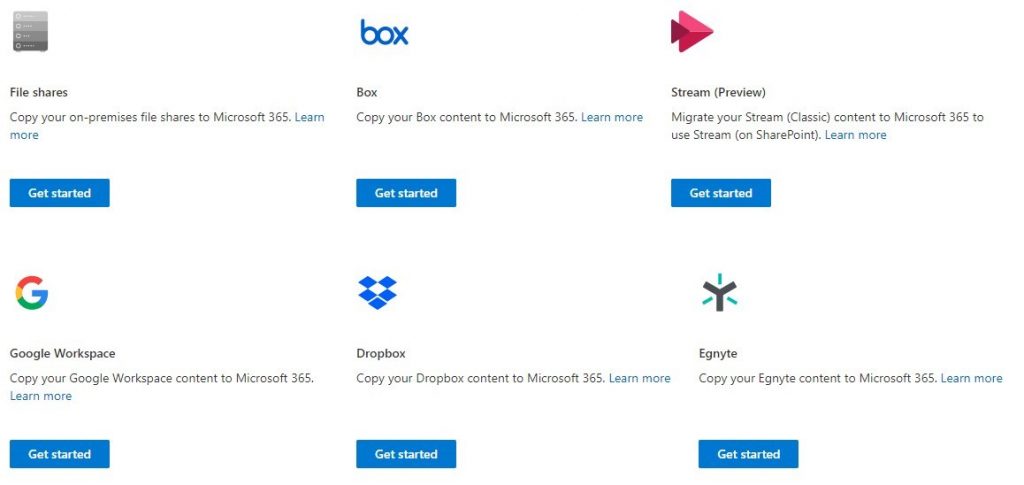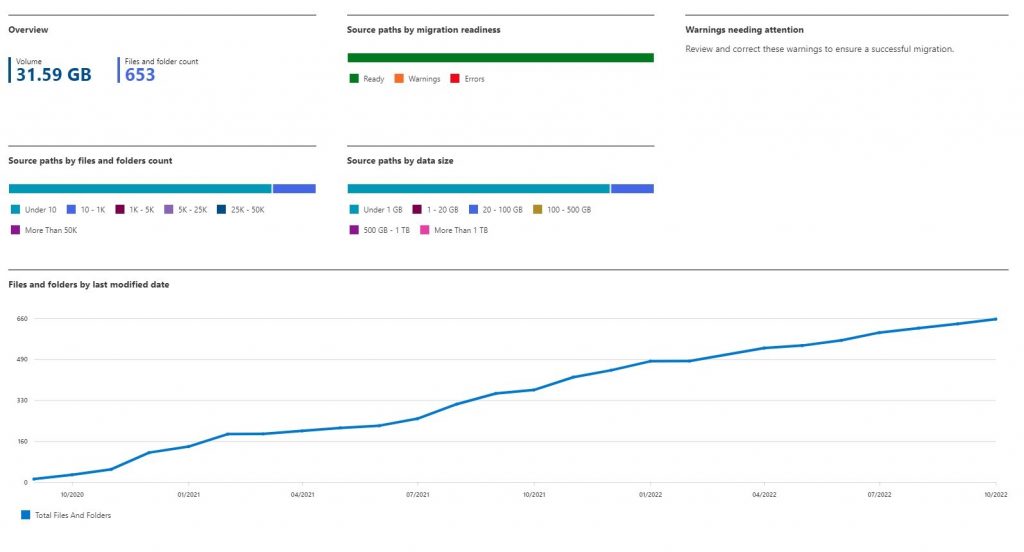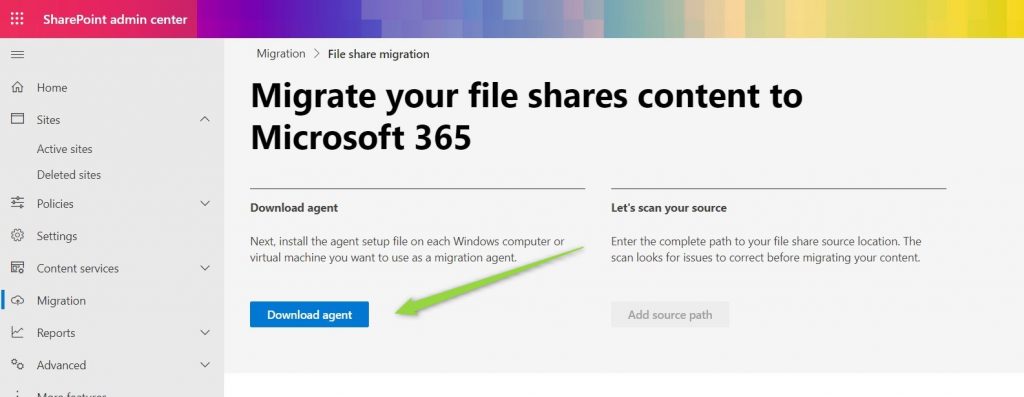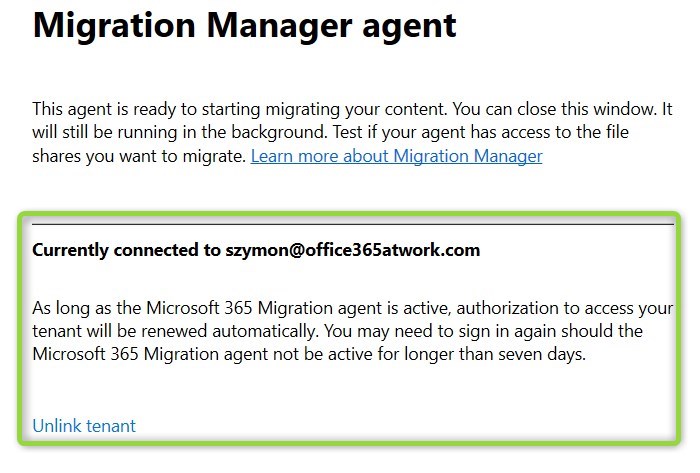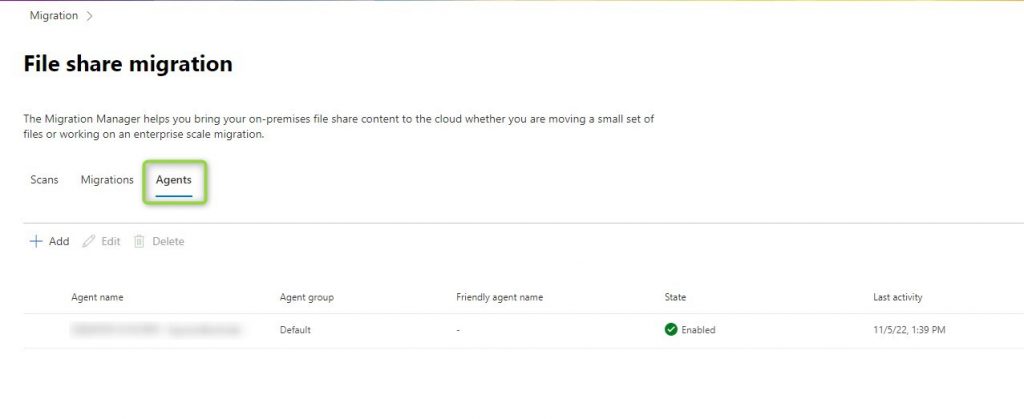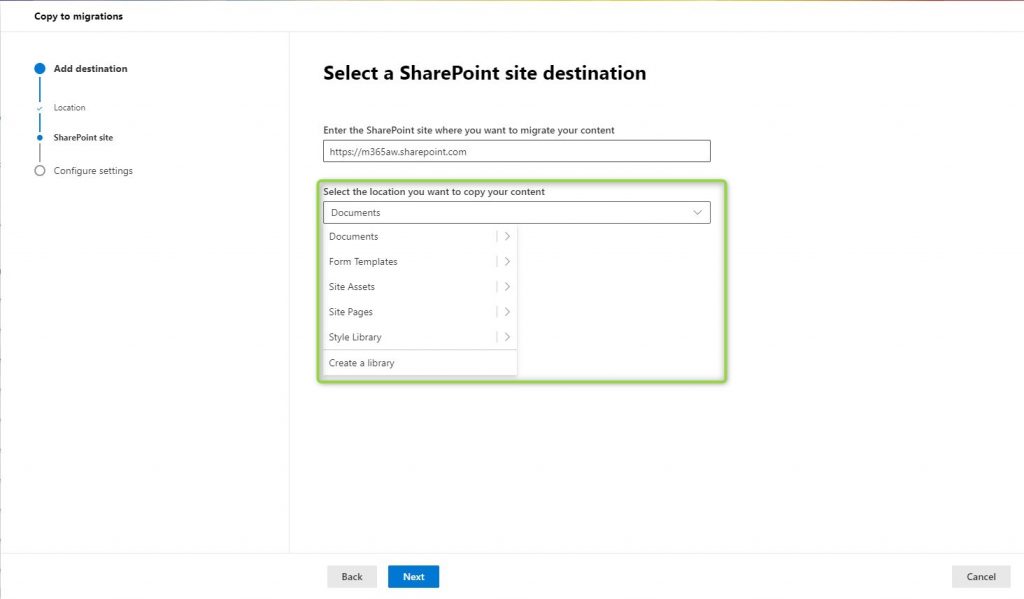Microsoft Migration Manager is a free migration tool provided by Microsoft that can help you to move to Microsoft 365
You can use Migration Manager to migrate the data to Office 365 from multiple cloud platforms and on-premise shares.
Cloud-to-cloud migration will be heavily used scenarios for organizations planning to migrate from Google Workspace, Box, or another cloud SaaS platform to Microsoft 365. Microsoft prepared a free migration tool based on legacy Mover.io that will help to move your data to Office 365.
Migration Manager is a great free tool that you can use to migrate your data from another cloud to Office 365.
Learn how to use Microsoft Migration Manager in the data migration process.
Mover.io retirement
Before we will dig into Migration Manager capabilities let’s take a short look at its predecessor – Moover.io
Moover.io is a legacy SaaS, web-based migration tool that allowed the migration of multiple cloud platform sources o Microsoft 365. This platform was acquired by Microsoft in 2019.
At the beginning of 2023 app in its native behavior available at https://mover.io will be retired.
Most of the Mover functionalities were transferred already to Microsoft Migration Manager which will allow you to connect to multiple cloud sources and migrate your data to Office 365.
What is Microsoft Migration Manager?
Migration Manager is a free migration tool provided by Microsoft that allows you to migrate from multiple clouds: Box, Google Workspace, Dropbox Agnyte and on-premise drives to Microsoft 365.
This is a great, free migration tool that could help you realize data cloud-to-cloud migrations to Microsoft 365. You can migrate large volumes of data to Microsoft 365 directly to SharePoint sites, OneDrive personal spaces or Microsoft Teams team Files.
When to use Migration Manager?
Cloud-to-cloud migrations in many cases could be quite complex that needs to be planned in detail. Platforms like Google, Box, Dropbox, or Egnyte are not mapping 1-1 to Microsoft 365 features.
You should select Microsoft Migration Manager in cases when you will not have the budget for enterprise migration tools or the volume of your data will be quite small. You need to remember that Migration Manager migrates only the data. If you will work on complex migration from Google Workspace to Microsoft 365 you will also need to take care about mail migration which is not supported.
Plus remember that Migration Manager is supported as a free tool. If migration will not work for your scenario it will be difficult to get professional support.
Data sources available in Migration Manager
You are able to migrate the data to Microsoft 365 from:
- Files Shares
- Box
- Stream Classic
- Google Workspace
- Dropbox
- Egnyte
You can connect to all these platforms and migrate your data to SharePoint, OneDrive or Microsoft Teams.
Which components can be migrated using Migration Managers
In the case of using Migration Manager, you are able to migrate the data and files. You will be also able to map internal components of the source platform to the specific space in Office 365.
You can migrate Box drives, Google Drives to OneDrive spaces in Microsoft 365, sites in SharePoint or Files in Microsoft Teams.
It is possible to manage the mapping using a CSV file.
Key Microsoft Migration Manager features
These are key features of the Migration Manager you should consider when you are planning the migration to Microsoft 365:
- File, folder, list items – Supports migration of files, folders, and lists.
- Permissions – Separate settings are available to set file permissions. Remember this feature could be limited to specific source platforms. Moreover, in the case of non-Microsoft sources, you will need to provide a user-mapping file
- Box drives or Google Drives or Google Shared Drives – these components can be migrated.
- Google files format will be converted – the tool will automatically convert files like .gsheet, .gdoc and .gslide to Microsoft formats.
- Unsupported signs – Linux-based systems could contain unsupported signs in the folder, file names. The tool will allow you to replace invalid characters.
- Scheduling the migration – you are able to schedule specific migration tasks and execute them in an unattended approach
- Multi-agent migration – you can setup multiple migration agents that will allow you to split the load and increase the migration performance
What is important these features will allow you to execute successful data migration to Microsoft 365.
Microsoft Migration Manager limitations
Limitations of the migration scenarios in the Migration Managers
- File shares
- Maximal size of the file is 250 GB
- Hosting the data platform needs to support SMB 2.0
- Box
- Maximal size of the file is 15 GB
- Box notes are not converted to. docs format
- Google Workspace
- Maximal size of the file is 15 GB
- Google Shared Drives migration is highly limited: permissions are not migrated, folder level permissions are also limited
- Drawings, Forms, Sites, and Maps from Drive are not migrated
- Restricted files cannot be migrated
- Shortcuts are not migrated
- Dropbox
- Maximal size of the file is 15 GB
- Egnyte
- Maximal size of the file is 15 GB
- A developer Egnyte account will be needed to make the migration work
- Problems with long file paths – During migration from Linux-based systems you can meet problems with maximum path length on the Microsoft side: 400 signs. The tool will list this kind of errors but will not fix them and do not migrate it
- There’s no support – If this tool will not work for your environment there’s not much you can do about it. Always verify how it works for your environment and your business cases. If it will broke you will need to try to fix it, there’s no enterprise support for the app.
- Limited logging – You can find some limited logs on the hard drive of your machine in the CSV format.
- Throttling – You should expect possible speed limitations on the source side.
Most of the listed limitations are on the source cloud platforms and there are the same limitations in the third-party migration tools.
How to download Microsoft Migration Manager for free?
You can get access to the Migration Manager tool by visiting SharePoint Admin Center for free. This is Office 365 migration tool which is web-based application available on the admin center.
Available features of Migration Manager
Microsoft Migration Manager offers the possibility of setup the migration from other cloud platforms to Office 365.
Sources of the data migration to Office 365 in Migration Manager
In the first step when you are set up the migration you can choose from on available sources
- File shares
- Box
- Stream Classic
- Google Workspace
- Dropbox
- Egnyte
In this step select your data source and start the Office 365 migration configuration.
Migration to Office 365 using Migration Manager
To start the migration to Office 365 you will need to do a few steps:
- Download the agent and install it on the machine where migration will be executed
- Scan the source / Access the source platform
- Import identity mapping
- Map the target environment to source assets
When you do this setup you can execute the migration.
Migration of the data from Shared Drive to Office 365 using Migration Manager
I will present to you how the set up the migration from a quite simple scenario when you are migrating from Shared Drive to Microsoft 365.
In case of the migration from cloud platforms, you will need to also prepare the identity mapping and probably do a lot more testing to be sure that the data format will be migrated without too many errors.
Install the Migration Manager agent
The first step is to install the migration agent on the migration machine.
You need to remember that the machine needs to be installed on the machine or VM with access to the source and target environment.
It is highly recommended to use domain-joined machines to be sure that the agent could work as a service. Service installation will allow you to continue migration during the “sleep” of the machine.
In the first step, you will be asked to authenticate to the Microsoft 365 tenant that will be the targeted environment.
At the next step, you will be asked to set up and test access to the source platform.
Your agent configuration is done.
You can install multiple agents and split the migration workload between multiple machines. In the Agents section, you will find all available migration agents with their state.
Add the source path mapping in the Migration Manager
In the next step, you will be able to scan your source environment.
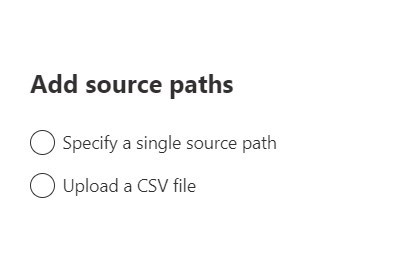
You will have the possibility to add the path manually or using CSV fil which could help you in bigger migrations.
Your added path will be queued for the scan which would deliver detailed information about data in the source environment.
As soon as your scan of the source environment will be done you will be ready for the migration to Microsoft 365.
As soon as your scan for the source will be ready for the migration you can move for the execution of the migration to Office 365.
Plan the data migration with Migration Manager
As soon as you will finish the scan of your source data you can start the planning of the migration to Office 365. You prepare the mapping between the source platform and Office 365 in a CSV file, use the results of the scan or add the migration setup manually.
Use Copy to migrations in the Scans to add the new migration task.
In the next step, you will need to select the target destio0nation for migrated data in Office 365.
You will be asked to select the site and library.
In the final step, you are creating the migration task.
A new migration task will be created.
In a few minutes or based on the schedule your migration will start.
Errors in using the Migration Manager app
Of course, when you are using Microsoft Migration Manager you can meet possible errors and problems. One of the most important elements that need to be guaranteed is proper connections to the source cloud data, possible throttling, limitations, and errors during migration.
Below I’m presenting some of the most popular problems you can experience and the table of the error codes.
Migration Manager logs
You can find the log from Microsoft Migration Manager on the local agent machine in the localization: C:\Users\USERNAME\AppData\Roaming\Microsoft\SPMigration
Migration Manager throttling
Throttling is a native security feature on Office 365 and it is not much you do about it. Prepare at least a few user’s accounts for the migration. One of the workarounds is to switch the account used to execute the migration.
The same behavior could be expected on the other cloud platforms from which you will transfer data.
Migration Manager local temp
Native localization for the Migration Manager temp is the C drive. Take into consideration that in case of migration temp could multiply the size of the migrated data. The migration option allows you to move it to another drive.
Migration Manager error codes
| Error Code | Recommended action |
|---|---|
| 0x00000000 | Unexpected error. |
| 0x01110001 | Unknown reason. |
| 0x0111000B | Path is too long. |
| 0x0111000F | The parent folder was not migrated. Check the failure report to determine the file and then try again. |
| 0x01110003 | Cannot access source folder. |
| 0x01110009 | Cound not retrieve the file metadata. |
| 0x01110010 | Invalid characters in the file name. Check report for files names with <>:”?*/, |
| 0x01110011 | The item “created time” or “modified time” is not supported. |
| 0x0201000D | Check if the list exists or if you can access it in the source site and target site. |
| 0x02050008 | Unable to access your local storage. Restart your migration. |
| 0x02010023 | Your source list template is not supported. Try another. |
| 0x0201000C | Check your credentials and then reenter your username and password. |
| 0x02010017 | You must be a site collection admin. |
| 0x02060009 | 1 – The site collection cannot be created because the URL is already in use or an invalid URL. |
| 2 – The site collection cannot be created because the URL contains invalid character. | |
| 3 – The site collection cannot be created or updated. | |
| 0x02060007 | 1 – The site collection cannot be created because the URL is already in use or an invalid URL. |
| 2 – The site collection cannot be created because the URL contains invalid character. | |
| 0x02010018 | 1 – Check your credentials and then try again. |
| 2 – A problem occurred accessing SharePoint. Check your credentials and try again. | |
| 3 – A problem occurred accessing SharePoint. Check your credentials and your network connection and try again. | |
| 4 – A problem occurred accessing SharePoint. Check your credentials and your site URL for accuracy and try again. | |
| 5 – A problem occurred accessing SharePoint. Check your credentials and the format of your URL. Retry. | |
| 6 – A problem occurred accessing SharePoint. Check your credentials and try again. If the problem continues, please create a support case. | |
| 7 – A problem occurred accessing SharePoint. Check your credentials and try opening your site in a browser. | |
| 0x0204000A | Cannot create package file. All files and folders in the Migration Manager working folder, %appdata%\Microsoft\SPMigration\Logs\Migration\MigrationToolStorage, must be closed. Restart your migration. |
| 0x02030001 | 1 – Check your credentials. Restart your migration. |
| 2 – Check your credentials. Restart your migration. | |
| 3 – Check your credentials and your network connection. Restart your migration. | |
| 4 – Check your credentials and your site URL. Restart your migration. | |
| 5 – Check your credentials and the format of your URL. Restart your migration. | |
| 6 – Check your credentials and restart your migration. If this continues, please a support case. | |
| 7 – Check your credentials and try opening your site in a browser. Restart your migration. | |
| 0x02010008 | Confirm the path and format of the user-mapping file and that you have permission to access it. |
| 0x02050001 | All files and folders in the Migration Manager working folder, %appdata%\Microsoft\SPMigration\Logs\Migration\MigrationToolStorage, must be closed. Restart your migration. |
| 0x02010002 | Check your network status. If you can access the source sites from a browser, then create a support case. |
| 0x02010010 | Make sure the source list and target list have the same template. |
| 0x0204000D | All files and folders in the Migration Manager working folder, %appdata%\Microsoft\SPMigration\Logs\Migration\MigrationToolStorage, must be closed during migration. Restart your migration. |
| 0x02040012 | The temporary storage on your local computer is too low. Migration Manager caches the package on the working folder. Expand your temporary storage and retry. |
| 0x02030003 | There are too many items with unique permissions. Simplify your permissions list by reducing the number of unique permissions. aRetry your migration. |
| 0x02050001 | Local storage file is corrupted. The working folder was touched or modified during the migration. Retry your migration. |
| 0x02080001 | The file in the package has been changed or deleted while uploading. All files and folders in the Migration Manager working folder, %appdata%\Microsoft\SPMigration\Logs\Migration\MigrationToolStorage, must be closed. Restart your migration. |
| 0x02040009 | The package can’t be created because the directory cannot be found. All files and folders in the Migration Manager working folder, %appdata%\Microsoft\SPMigration\Logs\Migration\MigrationToolStorage, must be closed. Restart your migration. |
| 0x02010020 | Disable migrating version history in Migration Manager settings or enable versioning in SPO. |
| 0x0201000E | Check if the global setting has filtered out special characters in the target path or if the path has unsupported characters. |
| 0X0201000F | Invalid site URL. Check if the site URL is valid. Try to access the URL via a browser. If this is a OneDrive account, make sure it has been pre-provisioned before you migrate. |
| 0x0207001 | You do not have access to the task folder. Check if you can access %appdata%\Microsoft\SPMigration\Logs\Migration\MigrationToolStorage. |
| 0x01410010 | A failure occurred because of missing dependencies on list items. Check the FailureSummaryReport.csv for details. Check if the dependencies have been included in your migration scope. |
| 0x01510001 | Packages failed to upload. If you have customized Azure storage, check if you can access the Azure storage and check if you can access the target site. Try migrating again. |
| 0x01510001 | Failed to Upload the Job to Server: Upload file failed during migration. |
| 0x02070009 | Several packages failed to upload. Pause the task and check your network connection. |
| 0x01710009 | A failure occurred due to job end failures; some items failed in the package. Restart migration. |
| 0x01710009 | Errors or timeout for Server Processing the file: Not all the items in the package have been migrated. |
| 0x01610001 | The Azure container is expired. Retry migration task. |
| 0x01710006 | Errors or timeout for server processing the file: Job Fatal Error. |
| 0x01710004 | Errors or timeout for server processing the file. Fail to look up folder name. The item may exist in other list or site in the same site collection. Or the item is in the recycle bin. |
| 0x0131000F | Failed to Read the file. File is checked out. |
What’s next?
Perfect! Now you know how to start using Migration Manager to move your data to Microsoft 365. Now is the time to learn more about Office 365. Learn about SharePoint Migration Tool, migrate SharePoint workflows to SharePoint Online or deploy SharePoint Lookbook templates.
Do you want more?
I prepared more articles around main Office 365 apps, like Exchange Online, Microsoft Outlook, Microsoft Teams and SharePoint Online.
Conclusion
Learn how to use the free Migration Manager and migrate your data to Office 365 from Box, Dropbox or Google Workspace.




